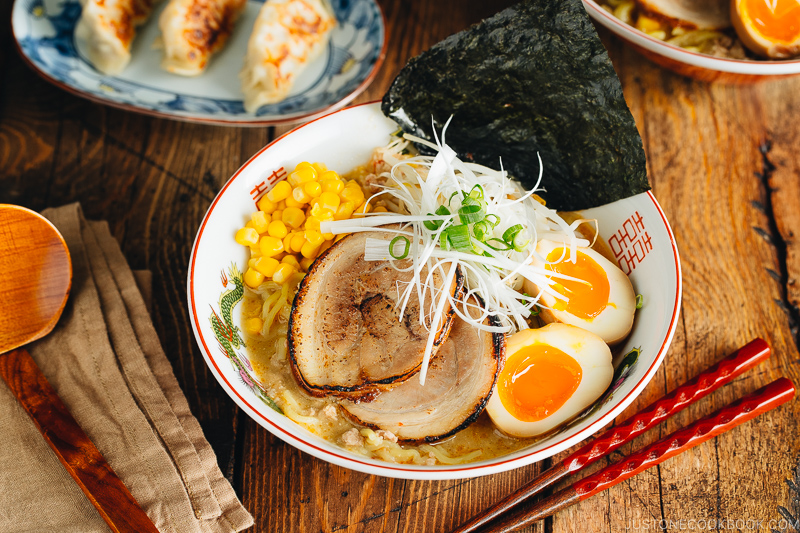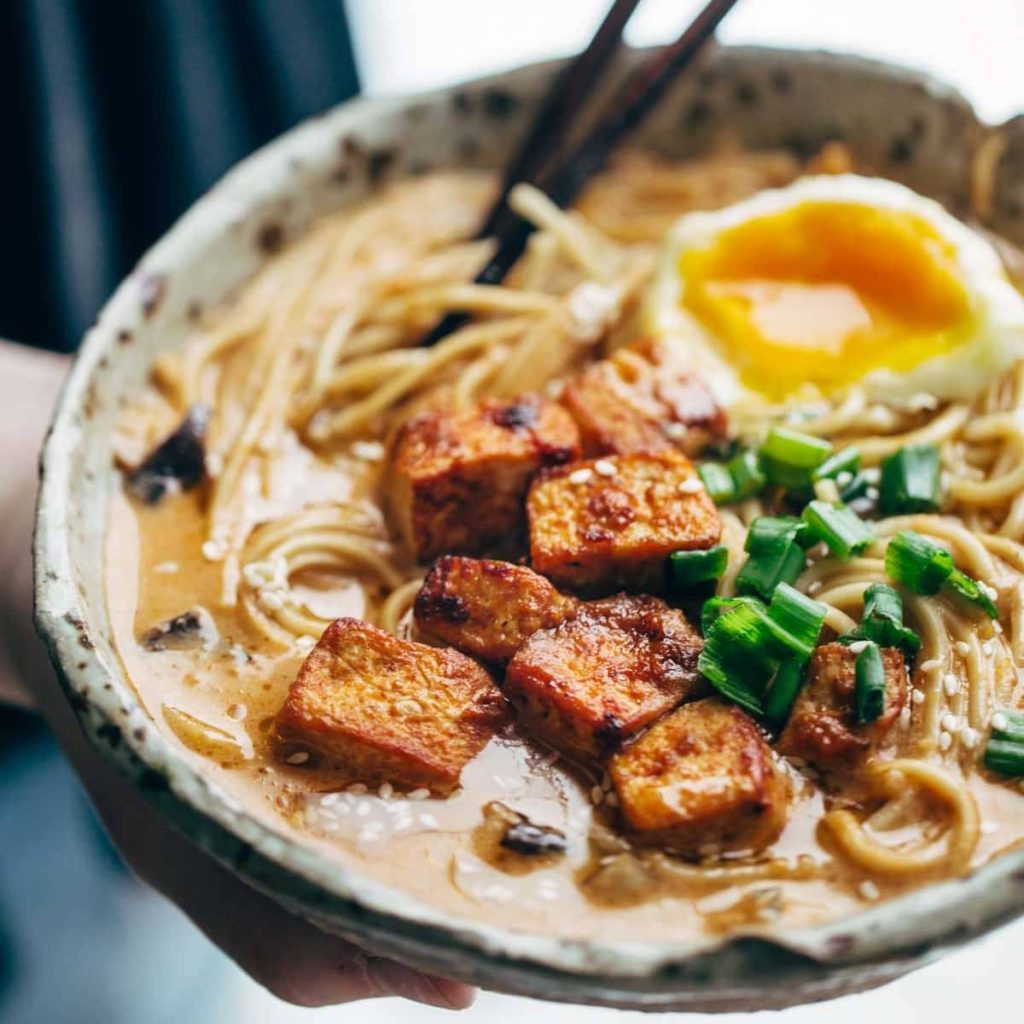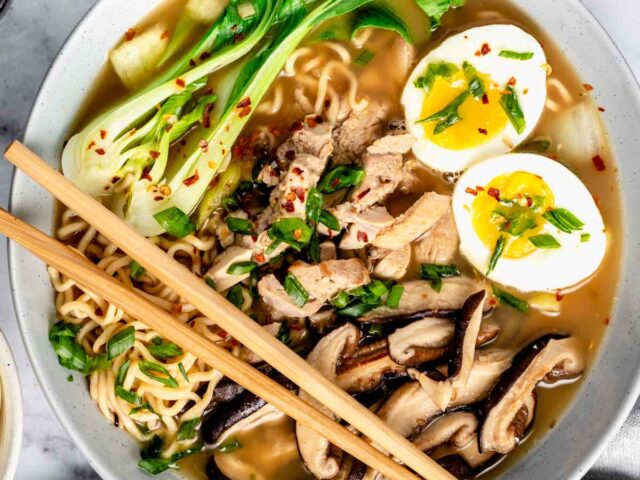Experience the comforting and flavorsome delight of Japanese Ramen Noodle Soup with this authentic recipe. This classic dish is known for its rich and savory broth, tender noodles, and a variety of delicious toppings that create a truly satisfying bowl of goodness. The star of the dish is the flavorful broth, simmered to perfection with ingredients like soy sauce, miso, and dashi, which infuse the soup with umami goodness. The noodles, cooked to a toothsome texture, soak up the flavors of the broth, providing a satisfying base for the toppings. Speaking of toppings, the possibilities are endless. From tender slices of chashu pork, marinated soft-boiled eggs, and crispy bamboo shoots to fresh green onions, nori seaweed, and bean sprouts, you can customize your ramen to your liking. The combination of textures and flavors creates a harmonious balance that will warm your soul and satisfy your cravings. Whether you’re seeking comfort on a chilly day or simply want to indulge in a bowl of authentic Japanese cuisine, this Ramen Noodle Soup recipe will transport you to the vibrant streets of Japan with each spoonful.
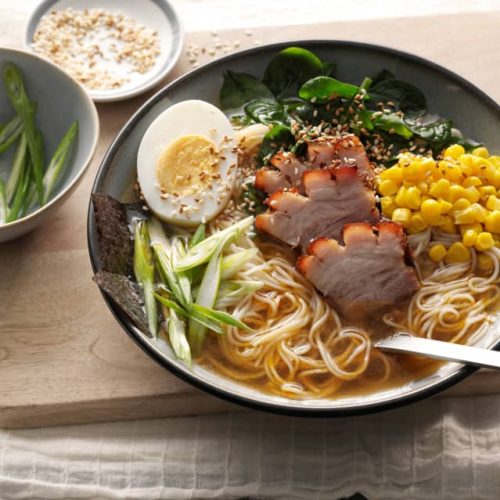
Japanese Ramen Noodle Soup Recipe
Equipment
- 1 pan
Ingredients
- 2 packs Ramen noodles
- 1 tsp Miso paste
- 1 cup Onion
- 1 cup Bell peppers
- 1/2 tsp Japanese fresh herbs
- 1 cup Water
- 2 tbsp Minced garlic
- 2 tbsp Minced ginger
- 1/2 cup Cilantro
- 1 cup Diced carrots
- 2 tbsp Olive oil
- 2 cups Vegetable stock
- 1/2 cup Water
- 1 cup Chopped tomatoes
Instructions
- Take a pan.
- Add in the oil and onions.
- Cook the onions until they become soft and fragrant.
- Add in the chopped garlic and ginger.
- Cook the mixture and add the tomatoes into it.
- Add the spices.
- Add the miso paste into it when the tomatoes are done.
- Mix the ingredients carefully and cover the pan.
- Add the vegetables and rest of the ingredients except the noodles.
- Let the mixture boil.
- Add the ramen noodles into the soup mixture.
- Let the soup cook for ten to fifteen minutes straight.
- Add cilantro on top.
- Your dish is ready to be served.
Video
Notes
FAQs
Q1: What are the main types of ramen broth?
A: The main types of ramen broth include shoyu (soy sauce-based), shio (salt-based), miso (fermented soybean-based), and tonkotsu (pork bone-based). Each type has its distinct flavor profile and ingredients, offering a wide range of options to suit different preferences.
Q2: Can I make ramen broth vegetarian or vegan?
A: Yes, it is possible to make vegetarian or vegan ramen broth. For vegetarian broth, you can use vegetable stock or kombu (dried kelp) as a base, and enhance the flavor with soy sauce and other seasonings. For vegan broth, omit any animal-derived ingredients and use plant-based substitutes or umami-rich ingredients like mushrooms and seaweed to add depth of flavor.
Q3: How do I achieve the perfect texture for ramen noodles?
A: To achieve the perfect texture for ramen noodles, follow the package instructions for cooking time. It’s important to cook the noodles until they are al dente, meaning they have a slight bite to them. Overcooking can result in mushy noodles, while undercooking can make them too firm. Rinse the cooked noodles with cold water to stop the cooking process and prevent them from sticking together.
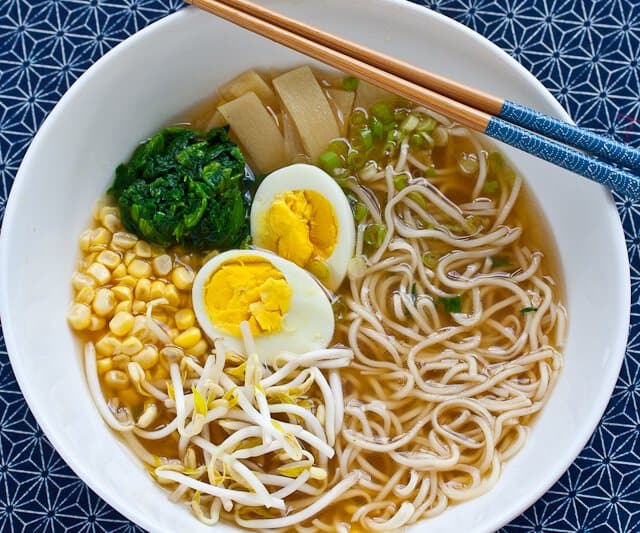
Q4: Can I use pre-packaged ramen noodles for homemade ramen?
A: While pre-packaged ramen noodles are convenient, they are often fried and contain seasoning packets with high sodium content. For a more authentic and healthier option, it is recommended to use fresh or dried ramen noodles specifically made for homemade ramen. These noodles have a better texture and can be found in Asian grocery stores or specialty food markets.
Q5: What are some popular ramen toppings?
A: Popular ramen toppings include sliced chashu (braised pork), soft-boiled eggs, bamboo shoots, nori seaweed, bean sprouts, green onions, corn kernels, and sesame seeds. Other options can include marinated tofu, mushrooms, spinach, or any ingredients that complement the flavor profile of your chosen ramen broth.
These FAQs should provide useful insights into common questions about making Japanese Ramen Noodle Soup. Feel free to experiment and personalize your ramen experience to create a bowl that suits your taste preferences and dietary needs. Enjoy the delicious journey of preparing and savoring this beloved Japanese dish!
Cooking Tip:
Here’s a helpful tip to enhance your Japanese Ramen Noodle Soup cooking experience:
1. Don’t overcook the noodles: To ensure the perfect texture, avoid overcooking the noodles. Follow the package instructions and cook them until they are just al dente. Remember that the noodles will continue to cook slightly in the hot broth, so slightly undercooking them will help prevent them from becoming too soft and mushy.
2. Keep the broth simmering: While preparing the other components of your ramen, keep the broth gently simmering on the stovetop. This will help the flavors develop further and keep the broth hot when it’s time to assemble your bowls. If the broth evaporates too much, add a little hot water or additional broth to maintain the desired consistency.
3. Customize seasoning: Taste the broth as you go and adjust the seasoning accordingly. Add soy sauce, salt, or other seasonings gradually to achieve the desired balance of flavors. Remember that different brands of soy sauce or miso paste may vary in saltiness, so it’s best to start with a smaller amount and add more if needed.
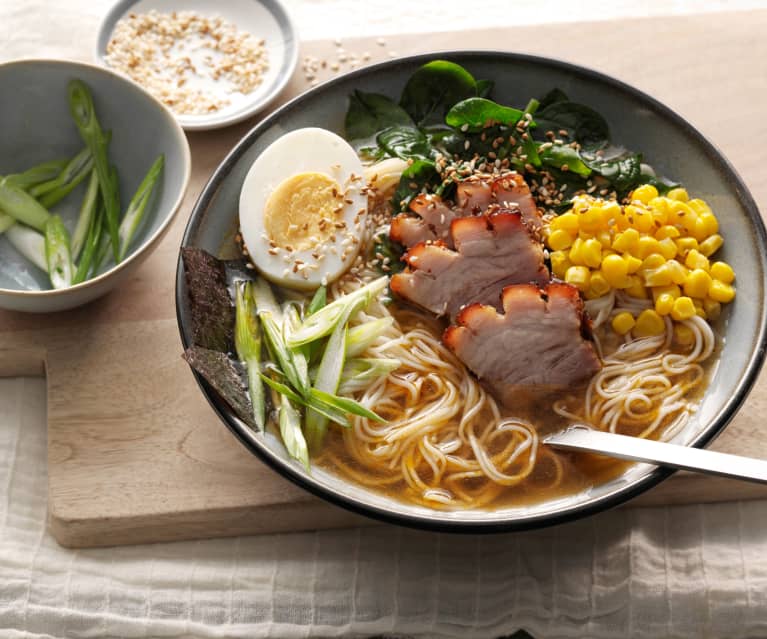
4. Prepare toppings in advance: To streamline the cooking process, prepare your toppings in advance. Slice the chashu pork, blanch the bean sprouts, chop the green onions, and have the soft-boiled eggs ready to go. This will make assembling the ramen bowls quick and efficient once the noodles are cooked.
5. Serve piping hot: Ramen is best enjoyed piping hot. Once all the components are ready, assemble the bowls promptly and serve immediately. This will ensure that the noodles stay firm, the toppings are fresh, and the broth is at its most flavorful.
By following these cooking tips, you’ll be on your way to preparing a delicious bowl of Japanese Ramen Noodle Soup that showcases the perfect balance of flavors, textures, and temperatures. Enjoy the satisfaction of creating an authentic and comforting dish in your own kitchen!
Serving Suggestion:
When it comes to presenting and serving your Japanese Ramen Noodle Soup, consider the following suggestions to elevate your dining experience:
1. Use traditional ramen bowls: Serve the ramen in authentic Japanese ramen bowls to enhance the visual appeal of the dish. These bowls are typically larger in size and have a wide opening, allowing ample space for the noodles, toppings, and broth.
2. Arrange toppings attractively: Place the toppings on the surface of the ramen in an aesthetically pleasing manner. This could include arranging slices of chashu pork, halved soft-boiled eggs, green onions, bamboo shoots, and other toppings in a visually appealing pattern. This not only makes the dish look more enticing but also allows each ingredient to be easily seen and enjoyed.
3. Add a pop of color: Incorporate vibrant ingredients to add a pop of color to your ramen. Consider garnishing the bowl with a sprinkle of red chili flakes, finely chopped cilantro or parsley, or a small pile of crunchy bean sprouts. These colorful accents not only make the dish more visually appealing but also add freshness and texture.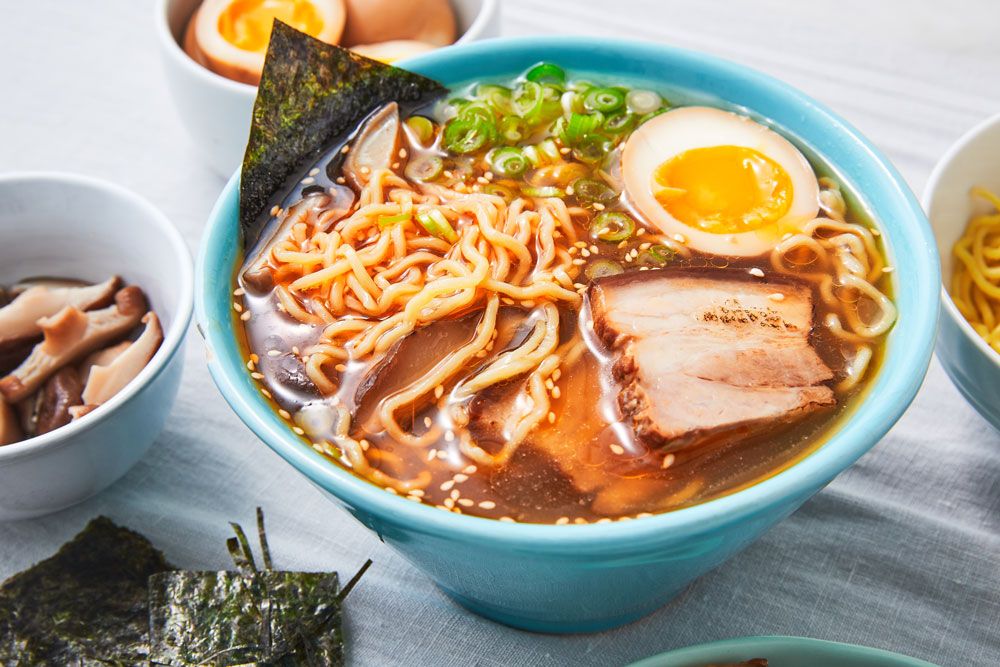
4. Serve with condiments: Offer a selection of condiments on the side, such as soy sauce, chili oil, sesame oil, or rice vinegar. This allows each person to adjust the flavors according to their preference. Encourage your guests to experiment with different combinations of condiments to create their own unique flavor profiles.
5. Provide chopsticks and spoons: Set the table with chopsticks and spoons for a traditional ramen dining experience. Chopsticks are ideal for picking up the noodles and toppings, while spoons are perfect for sipping the flavorful broth.
6. Offer side dishes: Accompany your Japanese Ramen Noodle Soup with some side dishes to create a well-rounded meal. Consider serving a side of steamed edamame, gyoza dumplings, or a refreshing cucumber salad. These additional dishes provide variety and complement the flavors of the ramen.
Remember to serve the ramen while it’s still hot, as the warmth of the broth and noodles is an essential part of the experience. With these serving suggestions, you can create an inviting and visually appealing presentation that enhances the enjoyment of your Japanese Ramen Noodle Soup.



